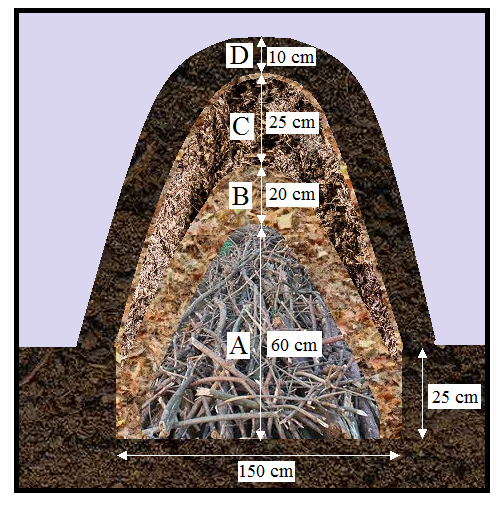1Aerate Your Lawn!

Lawn care experts recommend aerating your lawn at least twice a year. Cultivated garden areas will benefit from the same treatment. In the spring, before things wake up, grab an auger with a cordless drill and drill holes in the garden. Backfill some of these holes with sand, such as expanded shale or squeegee-sized gravel, an angular gravel whose particle size is smaller than pea gravel. Leave them open as they will naturally fill the other holes. Creating the holes will increase oxygen to the root zone. This is especially important for Western native plants to improve their longevity and bloom.
2Enrich the Soil with Coffee Grounds!
Used coffee grounds, for composting piles providing nitrogen and is an excellent organic resource that improves soil structure and slope. Coffee grounds are about two percent nitrogen by volume and are non-acidic – the acid in coffee is water-soluble, so the acid is mostly present in your coffee cup. When adding coffee grounds to a compost pile, add leaf and grass clippings in equal amounts.
When adding them to a static compost bin, add an equal amount of carbon source, such as shredded paper or dry leaves. Mix all the ingredients together thoroughly. Mix the soil into the soil while it is still wet (they repel water when dry) and also a nitrogen fertilizer add. Adding nitrogen is important because coffee grounds encourage the growth of microorganisms in the soil that use nitrogen for their growth and reproduction.
3Egg Shell for Slugs
If you have a problem with slugs in your garden, there is a simple and organic way to discourage them from feeding them with your plants and vegetables. Place crushed eggshells around your plants. There's no secret ingredient in the shells that slugs don't like, or a scientific reason behind this hack. Instead, there's a very practical reason to use the eggshell strategy: Slugs don't like the sharp edges of crushed shells. In fact, the jagged edges will pierce and kill their soft stems. Snails can cause unsightly damage to leaves and seedlings, especially in parts of your garden that tend to stay shady and moist. They are especially active after rains and in well-watered gardens. They also become attracted to fruits and vegetables as they mature. Slime tracks are clear evidence that slugs are present.
4Way to Prevent Other Creeping Insects
If you have a problem with crawling insects in your vegetable garden, wrapping a collar of aluminum foil around tomatoes and zucchini can help prevent unwanted creatures that want to eat your food before you do. As with the eggshell trick above, there is no science involved with this trick; it's just a practical tactic. Many crawling insects do not like to get through metal, and in this case the foil has the advantage of being somewhat sharp. It also acts as a physical barrier. For example, if you put it on squash, the borer won't be able to reach the base of the stem where they would normally nest.
5Use Epsom Salt for Tomatoes
It's no secret that Epsom salt, named after a brackish salt water source in Epsom in Surrey, England, has health and beauty benefits when added to bath water. Perhaps a lesser-known use of salt, which is no salt at all but a naturally occurring combination of magnesium and sulfate, is in the garden. Adding a limited amount of Epsom salt to tomatoes helps the fruit develop better because magnesium and sulfate are essential ingredients for plant growth. Michael Arnold, of Stone Avenue Nursery in Greenville, South Carolina, said he's heard adding Epsom salt around stressed plants will help them recover.
6Water the Pots with Wick
If you're a plant collector or a small-space gardener with a lot of pots, especially ornamental ferns in small pots, and tropical plants that can die if the soil dries out too quickly, there is a way to keep your roots moist. Wipe from old plastic food containers with lids or 2-liter plastic soda bottles using acrylic string or cord. This irrigation method can also be used in larger pots if you are going on a short vacation.
The idea is that the capillary action created by drawing water from a reservoir into the soil will keep soil moisture at levels that will make plants happy.
7Make Compost Stacks Do Double Duty

permaculture Make an easy entry into the world. A Hügelkultur garden consists of piles of rotting wood covered with earth. The more flimsy the better when constructing this type of bed, but any level of weathering can be used. Essentially, you are building a long-term compost pile covered with soil.
Once your mound is built, you erect it like any other raised bed. Not only is a huglkultur mound a great way to use your garden waste as a resource, but the best part is that you're eliminating the need for constant watering. Wood acts like a sponge, absorbing moisture and slowly releasing it into the surrounding soil. It tends to stay moist even in drought conditions, but not wet. You worry about watering your garden. are you on vacation? A mound of Hügelkultur that is watered before leaving will likely have enough moisture when you return after a week (or more). You can even do this with large pots and flowerpots.
8Make Your Own Insecticidal Soap
Dissolve 1 teaspoon of liquid dish soap in 4 glasses of water. Spray on plants infested with spider mites, whiteflies, aphids, or thrips. Insecticidal soap is not a preventative. It acts on contact and kills insects by suffocating or drying them, which means the solution must come into contact with the pest to be effective. Another use of insecticidal soaps is to use them to wash away honeydew, sooty mold and other debris from leaves. Insecticidal soaps are considered among the safest pesticides due to their low toxicity.
9Make a Garlic-Based Insecticide
Put a clove of garlic (a piece of the bulb) into the blender. Add 2 cups of water and blend until smooth. Pour the liquid into a container, cover and leave for 24 hours. Strain the solution through a cheesecloth or strainer into a large bowl. Dilute the garlic solution with 12 cups of water and add a drop or two of insecticidal soap to help the mixture adhere to the plant leaves. Garlic kills some insects by contact, so dilution is necessary. Dead bugs are a warning that you haven't diluted the solution enough (it can even kill good bugs). It can be preventative because the pungent smell of garlic repels a wide variety of insects.
10Use Baking Soda for Fungal Diseases
Dissolve 1 teaspoon of baking soda in 4 glasses of water and add a few drops of liquid dish soap to help the mixture adhere to the leaves of the plant. Spray the solution on the plants as a preventative against powdery mildew, rust and black spot. Repeat every 7 to 14 days or after rain. Baking soda's sodium bicarbonate properties make it a natural fungicide.
11Protect Your Wild Sturgeons Against Frost
- Water them well. Plants are less susceptible to frost damage if they are hydrated. Wet soil absorbs more heat than dry soil during the day and therefore emits more heat at night.
- Cover the plant. Cover the fabric to the ground and secure it with boards or rocks. This will capture the heat released from the soil under the blanket and keep it around the plant. Do not gather the fabric around the trunk. This will have the opposite effect of forcing all the heat from the soil out of the blanket. Be sure to remove the cap during the day.
- Trap heat near the plant. Place five 1-gallon buckets, or even jugs of milk filled with water, near the plant where they can remain under frost cover. Water is a heat sink that absorbs during the day and radiates heat at night.
12Grow Your Tomatoes in Cinder Blocks

Place the cinder blocks in your garden with the holes facing up. Plant a tomato in a hole, removing the leaves under the top of the cinder block. Fill the hole with garden soil. Fill half of the other hole with 10-10-10 fertilizer and fill the rest of that hole with garden soil. Water thoroughly on all sides. After that, water only the fertilizer side. Then get ready for the biggest, heaviest tomato plant you've ever grown!
Why would this work? Since roots will grow from tomato stems buried below the soil surface, will the ash prevent water and fertilizer from seeping into the root zone of the tomato? Does the cinder block add warmth to the root zone of the plant inside the cinder block? Is there a chemical compound beneficial to tomatoes in the slag block? All of the above? Has anyone tried this and can answer?
Note: You may still need to stake the tomato plant or put a trellis around it to support the sprawling plant, which is actually a vine. Certain or bush tomato plants that only grow to a certain height, depending on the variety, may not need support. But indeterminate tomato plants grow as vines and continue to grow and bear fruit until frost. These tomato plants will definitely need support to keep them from running where the fruit would be susceptible to rot or could be eaten by rodents.





























